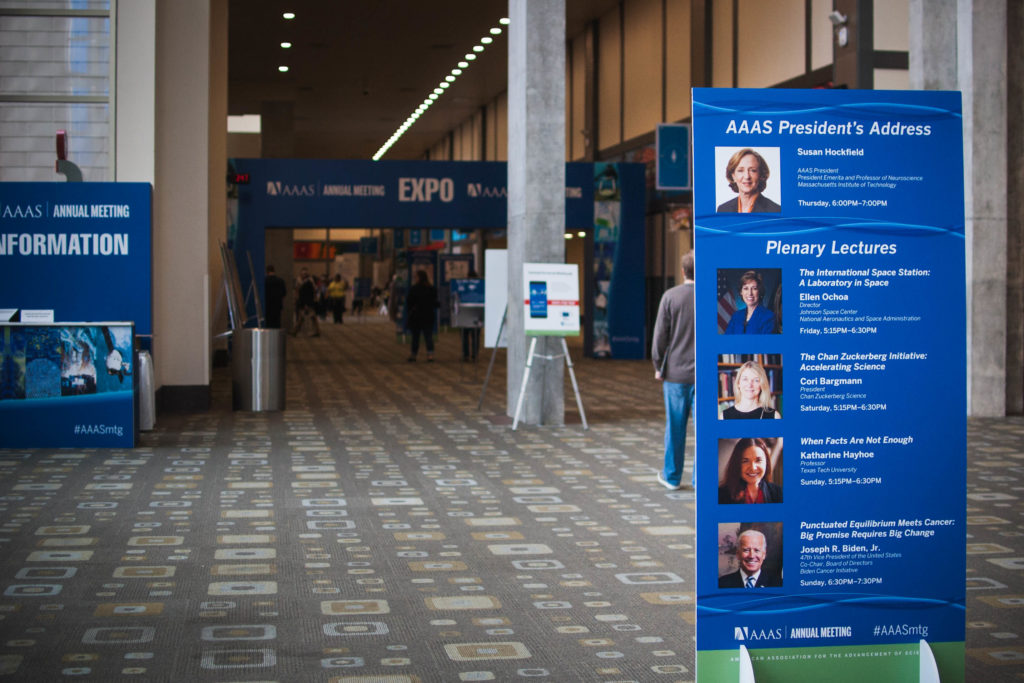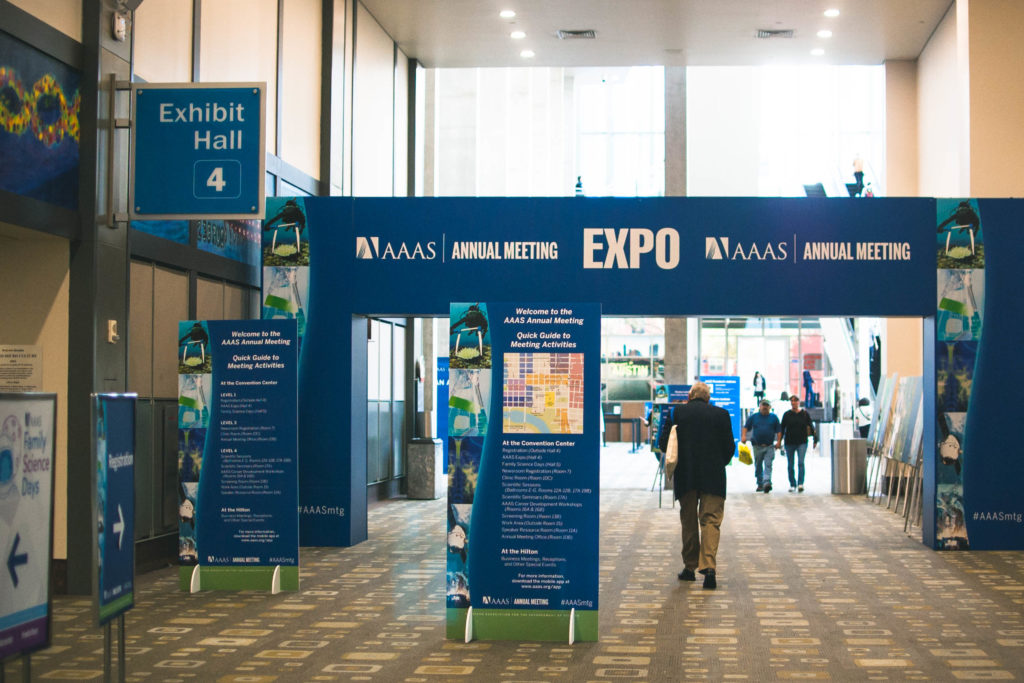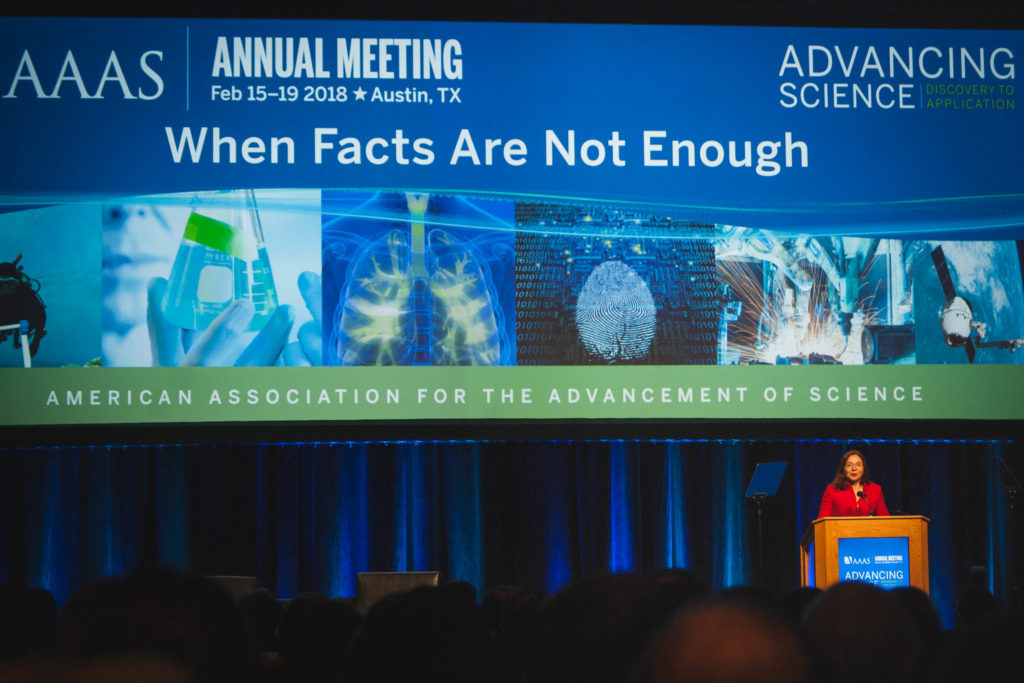
The 2018 American Association for the Advancement of Science (AAAS) annual meeting, themed “Advancing Science: Discovery to Application,” included plenary lectures, multi-speaker scientific sessions, career development workshops, and much more. An article in the Spring 2018 issue of Science Editor presented highlights of some of the sessions likely to interest science editors and those in related fields. The current article presents highlights of additional such sessions of this meeting, held February 15–19, 2018, in Austin, Texas; topics range from communicating with skeptical publics about climate change, to knowing what underlies conspiracy theories regarding science, to using social media to communicate research.
When Facts Are Not Enough
By Mabel Terminel
In this plenary lecture, Katharine Hayhoe—an atmospheric scientist at Texas Tech University and one of Time magazine’s 100 most influential people of 2014—addressed the challenges scientists currently face when talking with the public about climate change.
Hayhoe pointed out that as scientists, “facts are our lifeblood.” We thrive on disagreements, and we turn to research to solve our conflicts and find resolutions. So, what happens when facts are not enough? Overwhelming numbers of studies and amounts of data show we are facing a climate crisis. Yet, much of the population remains skeptical about whether climate change is real or whether these changes are driven by human activity.
It is easy to feel that we have tried to use every communication strategy, Hayhoe observed. Countless reports, studies, graphs, educational videos, and even comics on climate change are available to the general public. Still, the number of climate change skeptics in the United States remains high. Therefore some people have taken a different approach by trying to understand what causes someone to reject the vast evidence for climate change. Is it possible that people just do not know enough about it? Hayhoe pointed out that this is not necessarily so.
Hayhoe described a study by Larry Hamilton, a sociology professor at the University of New Hampshire. Hamilton asked people whether they believed climate change was caused mainly by human activity. He found that political affiliation was a predictor of opinions on climate change. The surprising finding was that among self-identified members of the Tea Party, the most skeptical group overall, those with more education were less likely to say they considered humans responsible for climate change.
Anticipating the audience’s next question, Hayhoe stated what she viewed as the real reason people deny climate change. She said that “what people have a problem with are the perceived solutions.” Specifically, people are concerned that the government is trying to take away their freedom by telling them what to do about climate change. Hayhoe said that to change people’s minds, we must convince people that the solutions are excellent and impacts of climate change are devastating.
Explaining how to engage in discussions with climate deniers, Hayhoe recommended taking a step back and trying a 3-step approach. First, find common ground: You can ask questions about people’s lives and listen to their stories. Once you find a way to genuinely connect with a person or group, help them see their personal connections with climate. The last step is to share solutions. Scientists are used to talking about problems but refrain from suggesting solutions, she observed.
Throughout the session, Hayhoe emphasized the importance of scientists’ being more than scientists and becoming advocates. “People love science when you can share your passion and enthusiasm,” she reminded her audience, ending her talk with an optimistic view.
Empirical Findings on Science Fairs: Experiencing the Nature of Science
By Chantal Cough-Schulze
At this session, speakers discussed the impacts and future of different kinds of science fairs. Science fairs, the speakers agreed, are vital for encouraging students in science.
University of Arkansas professor William McComas, the first speaker, provided an introduction to science fairs. He said science fairs should be meaningful to learners, use the methods of science, involve active debate, and be potentially useful to science. He noted that science teaching and science fairs fall on a spectrum regarding the level and kind of teacher involvement. A basic level of science teaching is demonstration: Teachers ask the questions, design and conduct the investigations, and form conclusions. Ideally, science fairs are at the opposite end of the spectrum, with students doing all these things instead of teachers. To better understand and improve science fairs, McComas called for more research about the impacts of types of science fairs.
The other 2 speakers each presented research about just that. Speaker Jacqueline DeLisi, of the Education Development Center, Waltham, Massachusetts, discussed “Science Fairs Under the ’Scope,” a National Science Foundation–funded national study on school-based science fairs. Among other findings, many students said the science fair taught them more about science or increased their interest in science—but not all students said both. Science fairs that mostly increased student interest were described largely as hands-on community events, or as one teacher put it, more of a carnival and less of a project board session. In a few school districts, students said science fairs made them dislike science more. In those districts, teachers indicated that they could not give students the support they needed.
Frederick Grinnell of the University of Texas Southwestern Medical Center, who organized the session, presented research about mandatory versus voluntary and competitive versus noncompetitive science fairs. He surveyed high school students who had recently participated in science fairs, as well as undergraduate and graduate students, some of whom had science fair experience. He found that students generally preferred noncompetitive science fairs and that the preference for noncompetitive fairs increased with the students’ education level. Some students said that competitive fairs were more about winning than learning, though the added incentive could be useful. Grinnell also surveyed students about the obstacles they faced and whether they received help from scientists in preparing their science fair projects. Students without help from scientists were more likely to list limited resources as an obstacle.
The speakers indicated that in order to give students the best experience, more research about science fairs is necessary. More resources would also help—McComas suggested giving science-fair mini-grants to schools to alleviate economic disparities. Grinnell said that currently there is not much mentorship from scientists regarding science fairs, and session audience members displayed interest in helping with that. The speakers enthusiastically encouraged interested scientists to contact their local schools about mentoring.

The Role of Conspiracy Theories in Perceptions of Fake News about Science
By Jessica Scarfuto
“Western medicine is racist!” “Scientists doing medical research are a cartel!” “The Earth is flat!” These are just some of the conspiracy theories addressed during this session by a panel discussing why people believe in conspiracy theories.
Stephan Lewandowsky of the University of Bristol, UK, began the session by looking at the public health impacts of some conspiracy theories and noting reasons for belief in such theories. As it turns out, he said, it is not that people do not trust scientists. Rather, people tend to look to conspiracy theories when science threatens their world views, profits, health, or other important aspects of their lives. “If you’re a smoker, it could be threatening to find out that smoking causes cancer,” Lewandowsky gave as an example. This leaves people with a choice: They can accept the science and adapt to the threat it imposes, or they can reject it and find an alternative explanation. Conspiratorially minded people, Lewandowsky said, gravitate toward the latter.
Asheley Landrum of Texas Tech University shared similar insights when discussing why, in 2018, there are still people who believe the Earth is flat. She found that conspiracy theorists did not differ significantly from the general population in scientific literacy but tended to share certain traits: They usually believed in biblical literalism, had a conspiratorial world view, and tended to reject institutions. These findings indicated that certain people gravitate toward conspiracy theories because the information suits their values and beliefs, not because they do not understand the science.
Finally, Benjamin Lyons of the University of Exeter, UK, discussed the role information plays in encouraging or combatting conspiracy theories. He noted that credible news agencies can contribute accidentally to conspiracy theories. As an example, he pointed to a recent CNN headline that read, “Military Deployed as Norovirus Outbreak Hits Winter Olympic Security Guards.” Lyons observed: “You might casually read that and start connecting the dots and think there’s some kind of military dispute between North and South Korea.” Although military personnel were replacing security guards just for medical reasons, a conspiratorially minded person might have a different interpretation.
Information such as that presented in this session may aid in communicating science suitably to those prone to favor conspiracy theories.
Science for All: Using Social Media to Take Your Research Around the World
By Alexandra Hoskins
“Has anyone been tweeting?” asked Lauren Biron of Fermi National Accelerator Laboratory to begin the career development workshop Science for All: Using Social Media to Take Your Research Around the World. The panel also included Mónica Feliú-Mójer of Ciencia Puerto Rico and Julie Haffner of CERN.
The session was geared toward scientists and others looking to promote their work, engage the public with it, and become more visible. The panel explained the most commonly used social media sites—Twitter, LinkedIn, and Facebook—with Twitter being the most used by scientists. They said social media can aid in explaining one’s science, sharing a slice of one’s life, providing updates, reaching reporters, forming connections, engaging in meaningful dialogue, sharing data, and unleashing creativity.
Included were short exercises in which audience members were asked to reflect on the individuals they wanted to reach, identify their goals, and brainstorm about ways to discuss their research. Emphasis was placed on staying true to oneself, owning one’s brand, and thinking before one reacts. Feliú-Mójer said that if what you have drafted causes you to pause and think, “If this was on the cover of [a newspaper] tomorrow, I would be really embarrassed,” edit the tweet or delete it. Other advice: Never react immediately to an inflammatory tweet or comment; cool off before responding.
Although creativity and self-expression were stressed, the session contained strong reminders of the “large ecosystem” of social media and its boundaries. Tweets are (usually) not private and can cause firestorms if not adequately vetted before entering the public’s view. One must also know his/her organization’s policy if working on an official site; otherwise, there can be communication nightmares and personal nightmares (i.e., getting fired!).
The question and answer session included tips such as putting one’s Twitter handle (@CScienceEditors, for example) on his/her presentation slides and trusting one’s organization’s public information officers when they provide guidance about social media. Employing social media is a useful and increasingly popular way to promote research and science more generally, but it does require work, and an appreciation of the scientific method can promote success. Haffner said, “Observe, try, try again, tweak, evaluate, and try again.”
You can check out tweets from the AAAS annual meeting using the hashtag #AAASmtg.

Training the Next Generation of Student-Communicators: Graduate Students Can Take on the Challenge
By Rachel Hoyle
At this career development workshop, a panel of 3 graduate students discussed the development, implementation, and sustainability of programs they had initiated to provide fellow graduate students with training in popular science communication. The panelists were Ben Cook, Harvard University (program: ComSciCon); Jesse Dunietz, Carnegie Mellon University (Public Communication for Researchers, or PCR); and Elyse Aurbach, University of Michigan (RELATE). Stephanie Guerra of Harvard University moderated the session.
To start a program, the panel suggested gathering 15 to 20 stakeholders in one room to get a sense of the need, the potential impact, and the resources available. Also, the panel said to find out what already exists to avoid “reinventing the wheel.” Resources that were mentioned included university media departments and local high schools or museums.
As graduate students in the sciences, the panelists approached the design of their programs scientifically. “You start with a hypothesis: what you think people want to learn. You test it and then evaluate it with questionnaires. And then you refine it,” Aurbach said.
The panel acknowledged the time constraints faced when starting a program, especially given the demands of graduate research. However, each panelist described the endeavor as an “unexpected benefit” in that he or she had something “meaningful and productive when laboratory research was not going well.”
Pros and cons of university backing also were addressed. Aurbach noted that university funds come with mandates that challenge the flexibility of RELATE. Dunietz argued that an à la carte style was integral to the success of PCR, which operates without university funds.
Each program provides skill-building workshops in addition to public-engagement opportunities for graduate students who are clearly “hungry for this.” The programs continue to not only thrive but also expand. As Aurbach stated, “We never ever have a problem filling workshops.”
Other offerings at the meeting included flash talks, student and general poster sessions, and business meetings of AAAS sections in scientific disciplines. Exhibitors included science-related institutions, scientific societies, and publishers of scientific books and journals. As usual at AAAS annual meetings, Saturday and Sunday also were Family Science Days, featuring demonstrations, presentations, and exhibits geared to young visitors.
The 2019 AAAS annual meeting, themed “Science Transcending Boundaries,” will take place February 14–17, 2019, in Washington, DC. For more information, please see https://www.aaas.org/.
Mabel Terminel is a graduate student in neuroscience; Chantal Cough-Schulze, Alexandra Hoskins, and Rachel Hoyle are graduate students studying science writing and science editing; Jessica Scarfuto is an assistant lecturer; and Barbara Gastel is a professor, all at Texas A&M University.
